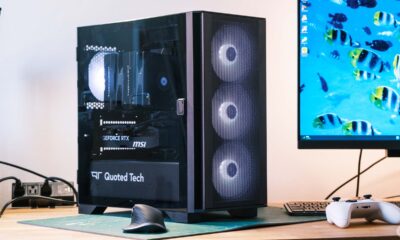Science
EeroQ Advances Quantum Computing with Floating Electrons

A team of researchers from EeroQ has made significant strides in quantum computing by developing a novel qubit system that utilizes single electrons floating on the surface of liquid helium. Their recent study, published in Physical Review X in early 2025, outlines the physics behind this groundbreaking approach, indicating potential pathways to scale quantum technology more effectively.
To understand how an electron can float above helium, Johannes Pollanen, the chief scientific officer at EeroQ, explains that the process relies on well-established physics principles. When a charged particle, such as an electron, approaches the surface of helium, it generates a weak positive image charge beneath the liquid. This interaction allows the electron to remain bound to its own image, despite the liquid helium’s chemically inert nature. The helium remains liquid at temperatures as low as 4 Kelvin, enabling practical applications without the extreme refrigeration methods often required for conventional quantum systems.
The research team employed a sophisticated setup that includes a tungsten filament and silicon chips to facilitate the trapping of individual electrons. By creating a controlled electromagnetic trap beneath a superconductive plate, they could manipulate the number of trapped electrons, allowing them to transition between three distinct states: zero, one, or two electrons. This precision is crucial for the development of qubits, the fundamental units of quantum information.
Pollanen noted that the successful trapping of a single electron represents a promising foundation for qubit architectures. The EeroQ team’s ambition is to store qubit information in the spin of these electrons, a concept previously tested in silicon impurities and quantum dots. Unlike those materials, isolated electrons in liquid helium benefit from enhanced spin coherence, making them potentially more effective for quantum computing applications.
Another notable advantage of this system is the use of standard CMOS technology for manufacturing. Pollanen emphasized that this allows for the construction of chips capable of hosting vast numbers of qubits—potentially reaching millions—while keeping control circuitry compact. This design minimizes the wiring required to connect qubits to external systems, streamlining operations.
The long-term vision for EeroQ involves pairing electrons with opposing spins to encode qubit information. Pollanen explained that this approach could mitigate decoherence effects, which are critical for maintaining qubit integrity during operations. The ability to move electrons and entangle qubits will play an essential role in the functionality of future quantum processors.
While the path ahead for EeroQ remains uncertain, the advances in their electron trapping system represent a significant step forward in quantum technology. As the team continues its research, the innovative work with floating electrons on liquid helium could serve as an exciting experimental platform, regardless of the eventual success in achieving practical qubits. The potential to reshape the quantum landscape remains a driving force behind EeroQ’s efforts, with the scientific community eagerly awaiting further developments.
-

 Lifestyle1 month ago
Lifestyle1 month agoWinnipeg Celebrates Culinary Creativity During Le Burger Week 2025
-

 Health2 months ago
Health2 months agoMontreal’s Groupe Marcelle Leads Canadian Cosmetic Industry Growth
-

 Science2 months ago
Science2 months agoMicrosoft Confirms U.S. Law Overrules Canadian Data Sovereignty
-

 Education2 months ago
Education2 months agoRed River College Launches New Programs to Address Industry Needs
-

 Technology2 months ago
Technology2 months agoDragon Ball: Sparking! Zero Launching on Switch and Switch 2 This November
-

 Science2 months ago
Science2 months agoTech Innovator Amandipp Singh Transforms Hiring for Disabled
-

 Technology2 months ago
Technology2 months agoGoogle Pixel 10 Pro Fold Specs Unveiled Ahead of Launch
-

 Science2 months ago
Science2 months agoChina’s Wukong Spacesuit Sets New Standard for AI in Space
-

 Technology2 months ago
Technology2 months agoWorld of Warcraft Players Buzz Over 19-Quest Bee Challenge
-

 Science2 months ago
Science2 months agoXi Labs Innovates with New AI Operating System Set for 2025 Launch
-

 Business2 months ago
Business2 months agoDawson City Residents Rally Around Buy Canadian Movement
-

 Business2 months ago
Business2 months agoNew Estimates Reveal ChatGPT-5 Energy Use Could Soar
-

 Technology2 months ago
Technology2 months agoFuture Entertainment Launches DDoD with Gameplay Trailer Showcase
-

 Technology2 months ago
Technology2 months agoInnovative 140W GaN Travel Adapter Combines Power and Convenience
-

 Technology2 months ago
Technology2 months agoGlobal Launch of Ragnarok M: Classic Set for September 3, 2025
-

 Education2 months ago
Education2 months agoAlberta Teachers’ Strike: Potential Impacts on Students and Families
-

 Technology2 months ago
Technology2 months agoNew IDR01 Smart Ring Offers Advanced Sports Tracking for $169
-

 Technology2 months ago
Technology2 months agoArsanesia Unveils Smith’s Chronicles with Steam Page and Trailer
-

 Technology2 months ago
Technology2 months agoHumanoid Robots Compete in Hilarious Debut Games in Beijing
-

 Science2 months ago
Science2 months agoNew Precision Approach to Treating Depression Tailors Care to Patients
-

 Health2 months ago
Health2 months agoGiant Boba and Unique Treats Take Center Stage at Ottawa’s Newest Bubble Tea Shop
-

 Technology2 months ago
Technology2 months agoQuoted Tech Launches Back-to-School Discounts on PCs
-

 Business2 months ago
Business2 months agoBNA Brewing to Open New Bowling Alley in Downtown Penticton
-

 Technology2 months ago
Technology2 months agoDiscover the Relaxing Charm of Tiny Bookshop: A Cozy Gaming Escape










